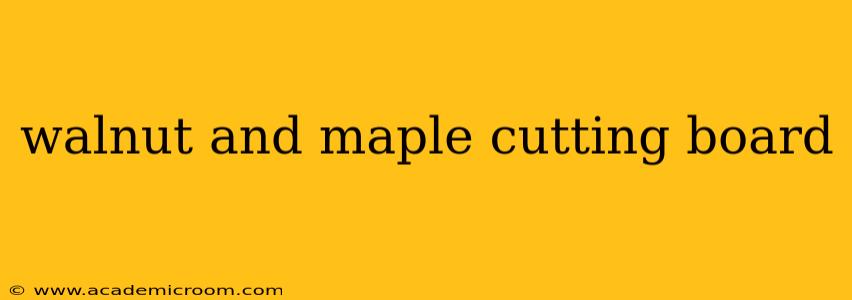Cutting boards are kitchen workhorses, enduring countless chops, slices, and dices. But not all cutting boards are created equal. The combination of walnut and maple creates a truly exceptional cutting board, offering both beauty and practicality. This guide delves into the world of walnut and maple cutting boards, exploring their benefits, maintenance, and how to choose the perfect one for your kitchen.
Why Choose Walnut and Maple?
Walnut and maple are prized hardwoods frequently used in cutting board construction for several compelling reasons:
-
Hardness and Durability: Both walnut and maple are relatively hard woods, resisting scratches and knife marks better than softer woods like pine or fir. This translates to a longer-lasting cutting board that maintains its integrity even with regular use.
-
Stunning Aesthetics: The rich, dark tones of walnut beautifully contrast with the lighter, often more vibrant hues of maple. This creates a visually striking cutting board that elevates any kitchen countertop. The grain patterns of both woods also add to their unique beauty.
-
Easy to Clean and Maintain: Properly treated walnut and maple are naturally water-resistant and relatively easy to clean, preventing the build-up of bacteria and odors.
-
Food Safe: Both walnut and maple are considered food-safe hardwoods when properly finished with food-safe oils.
What are the Differences Between End Grain and Edge Grain Cutting Boards?
This is a crucial consideration when buying any cutting board, including those made from walnut and maple.
-
End Grain Cutting Boards: These boards have the wood grain running perpendicular to the cutting surface. This design is gentler on knives, as the fibers absorb the impact of the blade, reducing wear and tear. They are also generally more durable and resistant to damage.
-
Edge Grain Cutting Boards: In these boards, the wood grain runs parallel to the cutting surface. While less expensive, they tend to dull knives more quickly and are more prone to scratches and gouges. However, edge grain boards are often easier to clean and maintain, and can be thinner than end-grain boards.
Many walnut and maple cutting boards are made with end grain construction, leveraging the benefits of both wood types for superior performance.
How Do I Care for My Walnut and Maple Cutting Board?
Proper care will significantly extend the life of your cutting board. Here's how to maintain its beauty and hygiene:
-
Hand Washing: Avoid putting your cutting board in the dishwasher. The harsh detergents and high temperatures can damage the wood, causing it to crack or warp. Always hand wash with warm, soapy water.
-
Drying: Thoroughly dry your cutting board after washing, ideally with a clean cloth. Allow it to air dry completely before storing to prevent mold and mildew growth.
-
Regular Oil Treatment: Periodically treat your cutting board with a food-safe mineral oil. This helps to condition the wood, preventing it from drying out and cracking, while also enhancing its water resistance. Mineral oil is non-toxic and safe for food contact. Follow the manufacturer's instructions on oiling frequency.
-
Avoid Soaking: Do not soak your cutting board in water. Prolonged exposure to water can damage the wood and increase the risk of bacteria growth.
What Size Cutting Board Should I Buy?
The ideal size depends on your needs and available counter space. Consider:
- Space: Measure your countertop to ensure you have enough space for comfortable work.
- Frequency of Use: If you cook frequently, a larger board might be beneficial.
- Types of Food Prep: Larger cutting boards are suitable for larger items like whole chickens or roasting vegetables.
Are Walnut and Maple Cutting Boards Eco-Friendly?
Choosing a walnut and maple cutting board supports sustainable forestry practices when sourced responsibly. Look for manufacturers who use sustainably harvested wood and employ environmentally friendly production methods.
How Much Do Walnut and Maple Cutting Boards Cost?
The price varies based on size, type (end-grain vs. edge-grain), and the quality of the wood. Expect to pay more for larger, high-quality end-grain boards. However, the investment is worth it for the longevity and beauty of a well-made cutting board.
By understanding the characteristics and care requirements of walnut and maple cutting boards, you can choose and maintain a beautiful and functional addition to your kitchen for years to come. Remember to select a board from a reputable source that uses sustainable wood practices.
